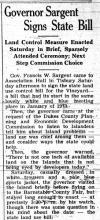The Martha’s Vineyard Commission voted 13-3 last night to approve a plan for a private 18-hole golf club on the site of an old subdivision in the rural perimeters of Edgartown, first spending nearly three hours developing a heavy set of more than 20 conditions which will force the developer to return to the commission on a number of fronts before the project can go forward.
Among other things, the commission voted to eliminate all the member housing planned for the project, to double the buffer area around a rare frost bottom on the property, and to require the developer to develop a completely organic management plan for the golf course.
“No ‘cides.’ No herbicides, pesticides or fungicides — period. Strictly organic,” said commission member Leonard Jason Jr.
Mr. Jason also led a move to eliminate a cluster plan for 15 houses on the property.
“Fifteen residential units for a golf course that is supposedly designed for people who live on the Vineyard — I don’t think those houses should be there unless they are for the help,” Mr. Jason said.
The remarks came during a rambunctious meeting of the commission which ran until after 11:30 last night.
The main subject of the meeting was the proposal by the Vineyard Golf Club Inc., which was pending before the commission as a development of regional impact (DRI).
The golf club is planned for the old Vineyard Acres II subdivision off the West Tisbury Road in Edgartown. The 245-acre property was approved as a 148-lot subdivision in the mid 1980s, but the subdivision was never built after the developers went bankrupt.
It was the second golf course proposal to date to come before the MVC. A proposal for an 18-hole golf course on 200 acres fronting the Edgartown Great Pond was narrowly rejected by the commission last month. A third golf course plan in Oak Bluffs has not been filed yet.
Owen Larkin, the managing partner for the Vineyard Golf Club, did not conceal his pleasure at the outcome last night, although the victory was also clearly dampened by the tough set of conditions.
“I am very pleased, but I hope there is some latitude in the two conditions which I find to be penal,” he said.
Mr. Larkin said the most troubling conditions are the elimination of the member housing and the extension of the buffer around the frost bottom.
“The ability to sell 15 house lots or lease 15 house lots made up a portion of the $16.2 million we are paying for this land,” Mr. Larkin said. “I will have to do an economic analysis, and that is a severe financial penalty,” he said. He also took issue with the 100-foot buffer, because he said there is no scientific evidence to support it.
Mr. Larkin must return to the commission with a new organic turf management plan.
There were many other conditions, including monetary contributions toward affordable housing, a requirement to provide 40 new beds for seasonal employees, and a provision that the golf club be available for local youth golf teams.
Mr. Larkin said he has no quarrel with the requirement that the golf course be 100 per cent organic.
“We have heard the Martha’s Vineyard Commission and the community on that. And we are willing to take the risk and to go with the the first truly organic golf course in this micro-climate and in the United States. We can do that, and we want to do that, “ he said.
Throughout the MVC discussion, the subdivision plan for 148 houses was an ever-present reminder.
“Underneath this I see a whole bunch of houses, and I wonder how this board would feel if they drive by and see those bulldozers,” said commission member Robert Zeltzer at one point.
Consensus did not come easily on the issue of the buffer areas around the 45-acre frost bottom on the property.
The discussion about whether to increase the protection around the frost bottom first surfaced at a meeting of the land use planning subcommittee on Monday afternoon. Last night Mrs. Sibley picked up the theme, proposing a condition that would create an average buffer of 300 feet around the frost bottom. The developer had proposed a 50-foot buffer.
Some members of the commission disagreed, pointing to the testimony from the applicant and also a recommendation from MVC staff for a buffer area of 50 feet.
“Am I misinformed when I think that the protection area being proposed is something the staff said was adequate?” asked Truman Henson, a member of the commission who represents the state Department of Environmental Management.
“Adequate is not good enough for Martha’s Vineyard,” fired back Mrs. Sibley. “This is a globally rare, threatened area and I want to challenge them to do an even better environmental design,” she added.
But Mr. Jason said he was comfortable sticking with the recommendations. “God did not come to me in the night, and the testimony showed that 50 feet was adequate,” Mr. Jason said.
In the end it took three votes before the commission could agree on the buffer. Mrs. Sibley’s motion for a 300-foot buffer was defeated, and so was a subsequent motion for a 50-foot buffer. Finally commission member John Best proposed a compromise of 100 feet and it was approved.
The final vote on the project came nearly three hours after the discussion began, and by the end, fatigue was apparent. When the last bits of discussion about conditions turned into a small haggle about how often the clubhouse could be used for events, MVC executive director Charles W. Clifford remarked wryly: “The first event at that clubhouse is going to be my wake.
Just before the final vote, commission member Tristan Israel made a last-ditch plea to turn the project down.
“I think we’re moving in the right direction, but I think it can be done better,” said Mr. Israel, who was one of three MVC members to vote against the project.






Comments